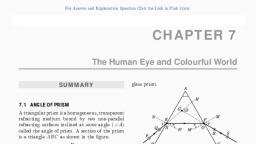Question 1 :
A student obtained a sharp inverted image of a distant tree on a screen placed in front of the concave mirror. He then removed the screen and tried to look into the mirror. He would now see:
Question 3 :
A convex lens makes a real image $4\ cm$ long on a screen. When the lens is shifted to a new position without disturbing the object, we again get a real image on the screen which is $16\ cm$ tall. The length of the object must be
Question 4 :
An object of height $1.5\ cm$ is placed on the axis of a convex lens of focal length $25\ cm$. A real image is formed at a distance of $75\ cm$ from the lens. The size of the image will be
Question 5 :
Various optical instruments like telescopes, microscopes, camera uses which property of light?<br>
Question 8 :
The power of two convex lenses $A$ and $B$ are $8$ diopters and $4$ diopters respectively. If they are to be used as a simple microscope, the magnification of
Question 9 :
The power of a lens is negative. State whether it is convex or concave?<br/>
Question 10 :
In order to get a diminished virtual image, the object can be placed anywhere in front of a :
Question 12 :
The incident ray, the normal at the point of incidence and the refracted ray:
Question 13 :
The distance between an object and its real image produced by a converging lens is $0.72\ m$. The magnification is $2$. What will be the magnification when the object is moved by $0.04\ m$ towards the lens?
Question 14 :
The power of a lens is $+2.0D$. Find its focal length and state the kind of the lens.<br>
Question 15 :
A concave mirror of focal length $f$ (in air) is immersed in water $(\mu=4/3).$ The focal length of the mirror in water will be
Question 16 :
If two $+5D$ lenses are mounted at some distance apart, the equivalent power will always be negative if the distance is
Question 17 :
A ray of light is incident at an angle i on a glass slab of refractive index $\mu$. The angle between reflected and refracted light is $90^o$. Then the relationship between i and $\mu$ is.<br>
Question 18 :
The magnifications produced by a convex lens for two different of an object are $m_1$ and $m_2$ respectively $(m_1 >m_2)$. If 'd' is the distance of separation between the two positions of the object then the focal length of the lens is
Question 20 :
A concave mirror forms the real image of an object which is magnified 4 times. The objects is moved 3 cm away, the magnification of the image is 3 times. What is the focal length of the mirror?
Question 21 :
A ray of light travels from ethanol into air. If the angle of incidence of the ray at the boundary is $30^0$ and the refractive index of ethanol is 1.36, what is the angle of refraction of the ray as it emerges out of ethanol?
Question 22 :
Two lenses whose powers are $4D$ and $-2D$ are kept in contact. The power of the compound lens is:
Question 23 :
A plate of thickness t made of a material of refractive index $\mu$ is placed in front of one of the slits in a double slit experiment. What should be the minimum thickness t which will make the intensity at the center of the fringe pattern zero?
Question 24 :
Assertion: Light waves have different refractive indices in different media.
Reason: Variations in the velocities of light in different media cause the refractive indices to be different.
Question 25 :
Calculate the magnification of an object if it is kept at a distance of $3 cm$ from a concave mirror of focal length $4 cm$:
Question 26 :
A slide projector gives a magnification $10.$ If a slide of dimensions $3$ cm $\times$ $2$ cm is projected on the screen the area of image screen is
Question 27 :
Two convex lens of focal lengths ${f}_{1}$ and ${f}_{2}$ form images with magnification ${m}_{1}$ and ${m}_{2}$, when used individually for an object kept at the same distance from the lenses. Then ${ f }_{ 1 }/{ f }_{ 2 }$
Question 28 :
Height of the image of an principal axis produced by a convex lens is double the object height . If the focal length of the lens is $20 cm$, then the image distance from lens is :
Question 29 :
A ray of light is incident from one medium $(\mu = 1.5)$ into another medium. If the angle of incidence and refraction are, respectively,$60$and$45$, thenwhatwill be the refractive index of the denser medium?
Question 30 :
A simple magnifying lens is used in such a way that an image is formed at $25\ cm$ away from the eye. In order to have $10$ time magnification, the focal length of the lens should be




























